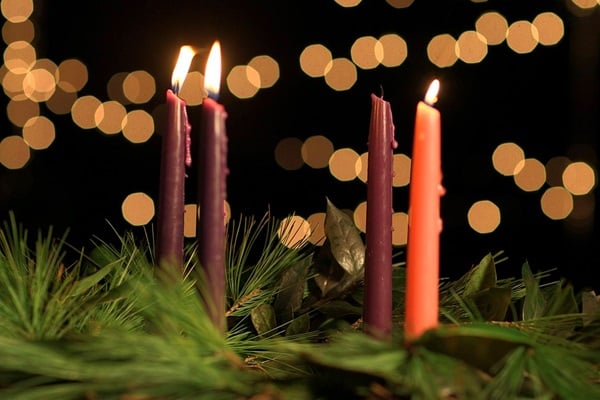The Advent wreath began as a German and Scandinavian home devotional practice used to mark the four weeks of Advent. Families would light a candle for each past week and the current week at their dinner or evening time of prayer. The configuration of candles, whether in a line or a circle, did not matter. Neither did the color of the candles (all colors are used in homes in Europe). What mattered was the marking of time and the increase of light each week in the face of increasing darkness as the winter solstice approached.
As Advent wreaths began to be used by congregations on Sundays in some places in Europe and America beginning in the late 19th century, several adaptations were made to make them work better in public worship spaces. Candles needed to be larger and more uniform than the "daily candles" handmade or purchased for home use. They also needed to be more uniform in color to fit with other décor in the sanctuary. That is why candles used in the Advent wreath are usually purple or blue, to coordinate with color of the paraments used during this season.
This shift in context from home to public use also made it important in the eyes of some for the candles to be given a meaning more that simply marking time and increasing light. This led to special ceremonies being developed for lighting these special candles each week.
As this practice began to catch on by the mid-twentieth century, several church supply houses who sold Advent wreaths and candles for public worship also developed resources, banners, and bulletin covers assigning a theme to each week, and thus each candle, based on scriptures from the one-year lectionaries used at that time. Those themes were Hope, Love, Joy, and Peace, in that order.
Today, almost no one uses those one-year lectionaries, so those themes may not always fit the scriptures we hear in worship. The one exception is the Third Sunday of Advent, where the current lectionaries have continued to support the centuries old observance of "Gaudete" or "Joy Sunday." That is why church supply houses often offer rose or pink colored candles for the wreath for use on this day.
So how may we talk about the meaning of the Advent wreath today?
We can reclaim the original home use of marking time with the hope of increasing light as we await the return of Christ, that day when "The city no longer has need of the sun or the moon to shine upon it, because the glory of God illumines it, and its lamp is the lamb."
And we can develop meanings or themes for each week based on the focus of the scriptures themselves. After all, the candles and the wreath are an accessory, not an end in themselves. Their meaningfulness comes from how we use them to point toward Christ, the world's true light, who was, and is, and is to come.





